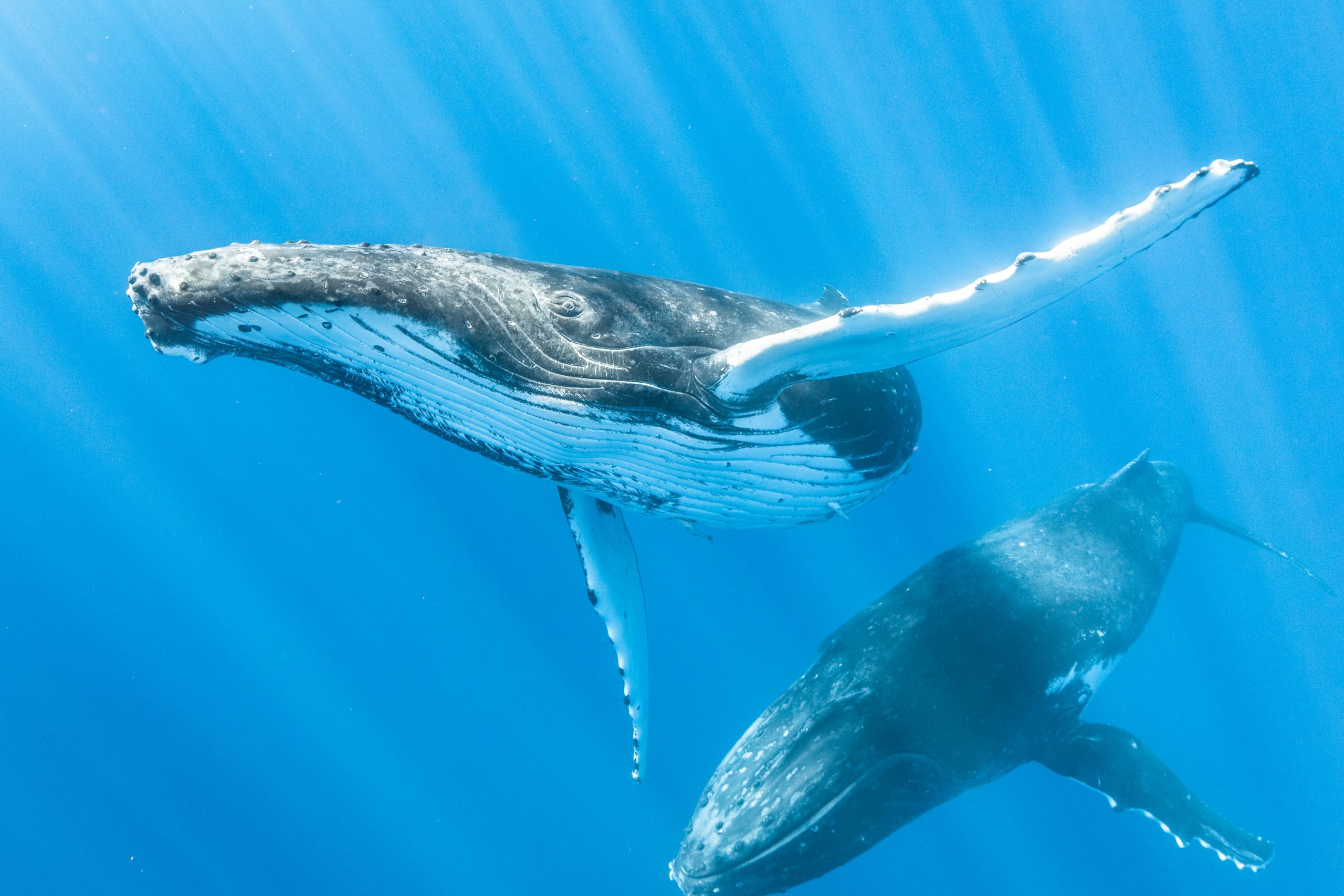Whale and dolphin watching
Addressing the activities and threats
- Last updated | 14 December 2023
Marine mammal watching often referred to as whale watching, includes tours by boar, by air or from land to see, swim with, and/or listen to [1]. Generating income, these activities enable paying tourists to observe cetaceans, beyond whales, dolphins and porpoises, including manatees, dugongs, pinnipeds and otters, for example, in their natural habitat. These activities provide tourism income and associated economic activity as well as employment for many communities around the world [2].
Well-managed marine mammal watching operations can lead to secondary benefits; local communities can foster pride and sense of stewardship for the marine mammals that benefit their economy, and the educational benefits both locally and in the broader sense are well-documented [3]. High-profile and responsible operations can raise the value of cetaceans in their natural environment with research indicating that such tourism-based activities have the capacity to increase the environmental awareness and conservation intentions of participants [4-6]. Finally, operators are also more likely to locate injured or entangled cetaceans while collaborating in research to obtain valuable data for cetacean [3].

Most impacts from whale watching activities relate to disturbances to cetacean behaviour. Vessels may trigger predator avoidance responses such as deeper and more frequent dives, or rapid changes in direction. The strength of this response, and thus the behavioural impacts, tend to increase with vessel proximity and greater boat abundance. Cumulative effects, with subsequent energetic costs, may occur when specific individuals or group of cetaceans are consistently exposed to watching activities. For example, resident whales or dolphins that are repeatedly interrupted during feeding or resting may be impacted more greatly over time than migratory individuals.
Although watching activities concerning cetaceans have, on a few occasions, been linked to a population disturbance [7] or a movement of animals away from the area targeted for tourism, dolphins have been more noted for their longer-term behavioural changes, such as avoidance of vessels and swimmers, and population decreases.
Whale and dolphin watching, therefore, must be carefully managed in order to maximise the benefits of education, public awareness, and conservation, while minimising the impacts on species and populations, particularly given that some species are threatened or vulnerable [8].
Impact minimisation mainly involves strategies to reduce stress or disturbance to the animals and reduce the likelihood of other adverse behavioural changes. Strategies will vary depending on the species concerned but should be based on the best available science.
Stress and disturbances can be limited through the application of regulations concerning approaching individuals or populations of cetaceans (e.g. direction of approach, vessel speed, proximity to cetaceans, numbers of vessels allowed in the vicinity of an ‘encounter’ etc.). In addition, physical contact with cetaceans and the use of scuba should be prohibited, and loud noise should be discouraged.
Other adverse behavioural effects can be reduced by bans on feeding, and cumulative effects on individuals, groups or populations can be reduced through limits on the number of operator licences and frequency and/or duration of trips whilst also noting seasonal changes in populations and individual life histories. For example, this could include prohibiting watching activities during breeding season.
Given that tourists often wish to have a ‘close encounter’, pressure may be felt by operators to bend or break the guidelines, especially where market competition is high. Therefore, regulations with penalties are preferable to guidelines. National or State government laws or regulations may also provide added management power. Enforcement of regulations, particularly in offshore areas, can be enhanced by the presence of observers and trained (and importantly, empowered) naturalists on board, and the use of vessel tracking systems.
Created to supervise an expanding tourism activity and guide volunteer operators, the High-Quality Whale-Watching® certification is an ACCOBAMS (Agreement on the Conservation of Cetaceans of the Backs Sea, Mediterranean Sea and contiguous Atlantic area) trademark jointly developed with the Pelagos Sanctuary.
This certification is in line with a naturalist approach. Cetaceans are wild animals moving in a vast environment and their observation during every trip cannot be guaranteed. That is why certified trips do not target exclusively whales and dolphins. Operators will be keen to show you the marine biodiversity in general: marine birds, fish, turtles, etc.
Besides, the certification guarantees a whale and dolphin approach respectful of the code of good conduct for the observation of Mediterranean cetaceans enacted by the Pelagos and ACCOBAMS Agreements.
Moreover, educational information acquired during a training course is provided to you by the certified operator all along the trip. The training course is organised by Souffleurs d’Ecume, in charge of implementing the certification in the French Mediterranean Sea.
Finally, in the framework of responsible ethics certified operators commit to waste sorting on-board their vessels.
[1] Walker, R. 2019. Evaluating marine mammal watching legislation, regulations and codes of conduct. Winston Churchill Memorial Trust Report. 50pp.
[2] Whale watching- International Whaling Commission
[3] Benefits of Responsible Whale Watching
[4] García-Cegarra, A. M. & Pacheco, A. S. Whale-watching trips in Peru lead to increases in tourist knowledge, pro-conservation intentions and tourist concern for the impacts of whale-watching on humpback whales. Aquatic Conservation: Marine and Freshwater Ecosystems, n/a-n/a, doi:10.1002/aqc.2754 (2017).
[5] Lopez, G. & Pearson, H. C. Can Whale Watching Be a Conduit for Spreading Educational and Conservation Messages? A Case Study in Juneau, Alaska. Tourism in Marine Environments 12, 95-104, doi:10.3727/154427316X14779456049821 (2017).
[6] Zeppel, H. & Muloin, S. Conservation Benefits of Interpretation on Marine Wildlife Tours. Human Dimensions of Wildlife 13, 280-294, doi:10.1080/10871200802187105 (2008).
[7] Amrein, A., Guzman, H., Surrey, K., Polidoro, B. and Gerber, L., 2020. Impacts of Whale Watching on the Behavior of Humpback Whales (Megaptera novaeangliae) in the Coast of Panama. Frontiers in Marine Science, 7.
[8] Conservation and Values – Global Cetacean Snapshot – a progress report
If you would like to get in contact with us, please use the button below.
Copyright 2022 © All rights Reserved. Design by piknetart.com